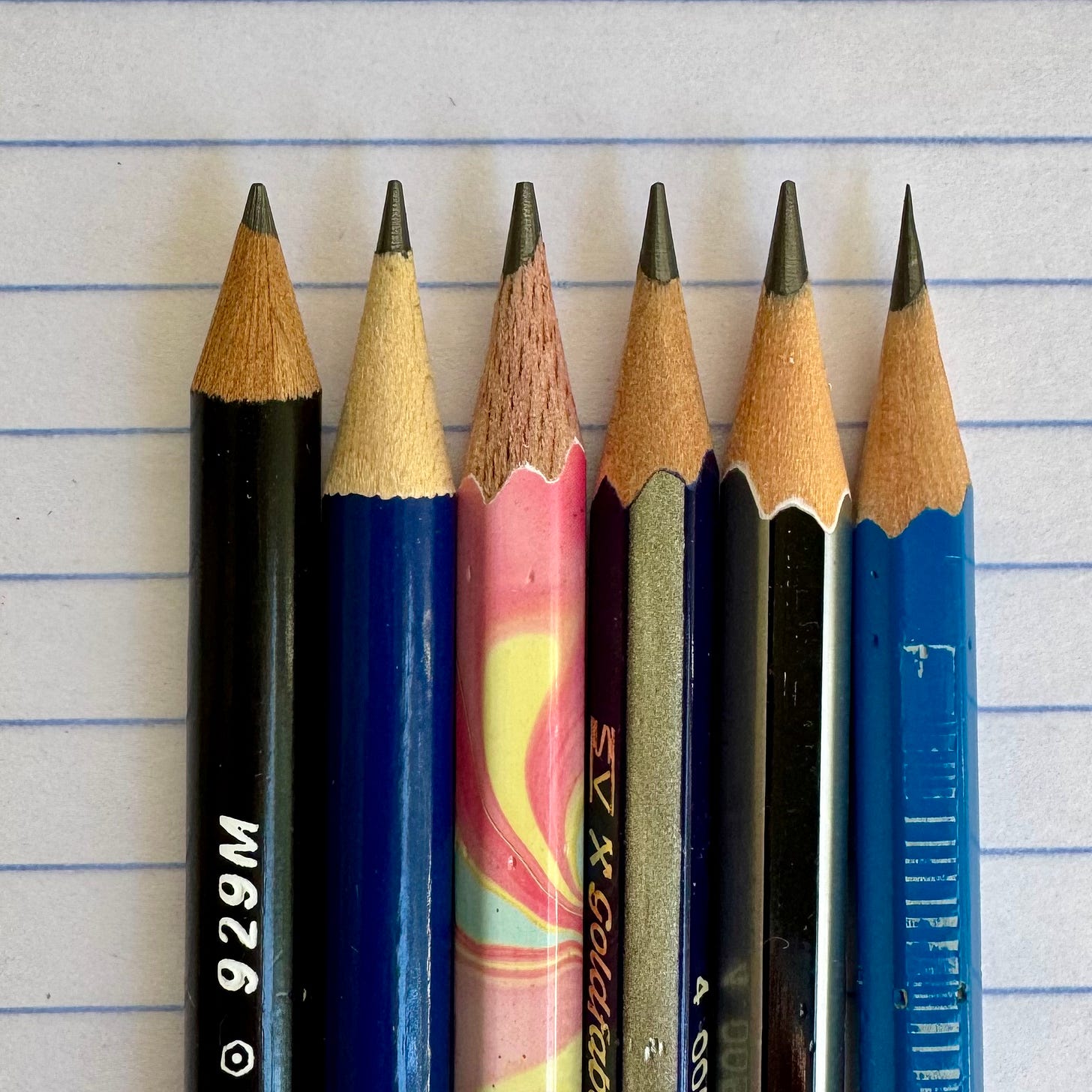I have never been to the Paul A. Johnson Pencil Sharpener Museum1, but I have crept on it online like an ex who’s suddenly looking awful single on social.
I’m a pencil person. This is the sort of obsessive thing we might do (in a good-natured, non-stalker way, to be clear). I know about this quirky little museum thanks to Mary Norris, storied long-time copy editor at The New Yorker.
Norris’s excellent 2015 memoir-slash-grammar guide, Between You & Me: Confessions of a Comma Queen, includes a chapter titled “Ballad of a Pencil Junkie” (you & me both, Norris), in which she rhapsodizes on her preference for No. 1 pencils and some not insignificant frustrations trying to keep a particular stockpile of them sharpened. In that chapter, she also stops at the pencil sharpener museum while visiting family in Ohio. A narrative side trip to an actual roadside attraction.
Anyway, back to pencils.
I’m not as singularly focused as Norris on the type. In fact, I like to have plenty of options at hand. To be able to pick one up based on the task or aesthetic whim of the moment. (When I sat down to draft this set of musings, I grabbed a Faber-Castell Goldfaber 1221 HB, its hexagonal body painted a smart, glossy midnight-blue with alternating facets washed in a stripe of pale gold.)

While I like most pencils, I don’t like a lot of pencil sharpeners. Sometimes the pencil doesn’t fit exactly right in the sharpener and the shaft ends up chewed away asymmetrically, the point lasting only half as long before a tooth of jagged wood scrapes against the paper. Or the angle of the sharpened cone is too wide or too steep. And don’t even get me started on the ravenous jaws of electric sharpeners. (I’d nickname them beavers, but beavers don’t deserve that kind of maligning.)
Most people I know who like and use pencils have at least moderately strong opinions about their preferred sharpeners. This is mine: the Dahle 166 Premium. I’m attached to the model in part for sentimental reasons. We had one in our house when I was growing up; my artistically inclined mother bought it at a little independent art supply store in Santa Fe. (Narrative detour: My mom went to business school when I was six and got a bookkeeping certificate to support us, but it’s her arts and crafts side that most defines her in my heart. We had annual Valentine’s card-making parties. She helped me craft an elaborate display of flour-clay dinosaurs and tissue paper palm trees for a second grade project that I can still see clearly in my mind’s eye. And I don’t remember ever believing that Santa Claus was “real” because I recognized her hand in the elaborate, swooping, marker-drawn signs that accompanied whatever special gift was waiting for my sister and me on Christmas morning.)

Beyond sentiment, I bought my own Dahle sharpener a few years ago because I remember it worked. You can set your preferred sharpness or bluntness with a dial on the hand crank. There’s an adjustable grip that holds a wide variety of pencil widths (see above re: myriad options at hand) and automatically feeds the tip to the blade. And when the pencil gets to the set sharpness, the handle spins without chewing any further into the shaft. (See if you can hear that in the little audio bit below.)
The Dahle’s one drawback is that the grip does leave teeth marks, marring the aesthetics of the pencil. But I can live with that, the way I try to love the laugh lines at the edges of my eyes, the concentration furrows between my brows, or the color of my hair, which has mostly faded from chestnut right through graphite and on to silver now.
The Pencil Sharpener Museum sits on the grounds of the Hocking Hills Regional Welcome Center, just off U.S. Route 33 in Logan, Ohio, in what now looks like a moderately above-average backyard shed. The collection, more than 3,400 mostly novelty sharpeners, started as a probably innocuous gift. A couple of car shaped sharpeners given by a wife to her husband ended up launching an obsession, a collection, and eventually a very specific tiny museum. It was housed on the collector’s property until sometime after his death, when the Hocking Hills Welcome Center became the keeper and host of the shed and its contents. I called the welcome center last July to see if the museum was still there and what the hours were, and the nice human on the phone told me it would be closed for a stretch while they were building a new home to replace Johnson’s original shed. The tidy new building opened its doors last January, so you can stop in if you happened to be cruising through the Buckeye State.





